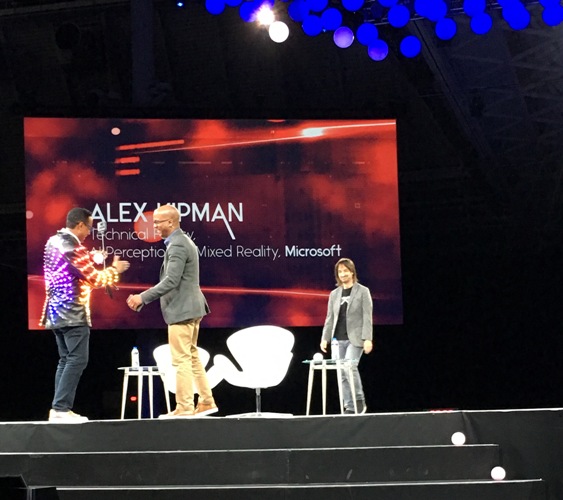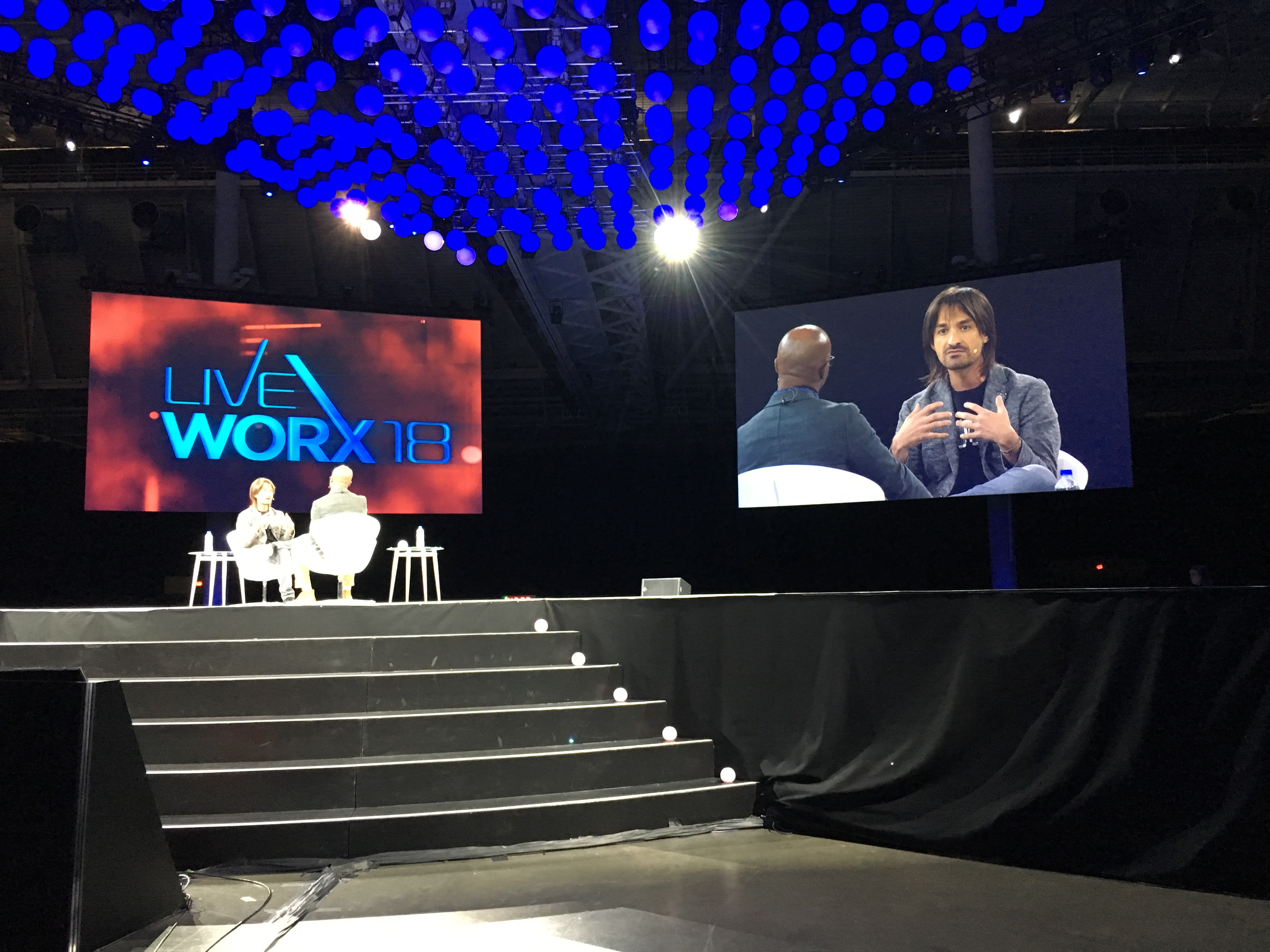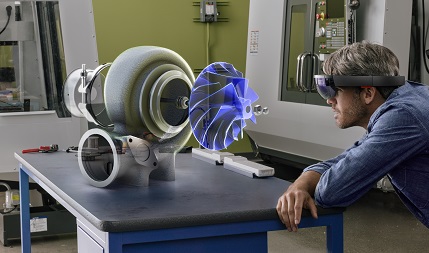The organisers of #LiveWorx2018 in Boston, USA, saved something special for the end. CNBC’s Jon Fortt interviewed Microsoft’s Mixed Reality team lead, Alex Kipman live on stage, in a discussion that held an audience of more than 3,000 engrossed as they explored the future. Jeremy Cowan reports from PTC’s annual 3-day tech summit.
Alex Kipman dived straight in when asked how mixed reality is being used today. “In China, doctors have done over 300 operations using mixed reality to image the patient in 3D. They’re super-imposing MRI information onto views of the patient’s body.”
It didn’t take long for the $64,000 (€ 55539.20) question to come from Jon Fortt. When, he wondered, will mixed reality (MR) be a game changer? There seemed to be no doubt in his mind that it would.
The Future is already here
Said Kipman, “There’s a well-known quote that says, ‘The future is already here’. Last year there was little MR here at LiveWorx. Now it’s all across the show floor. MR is the perfect interface for data coming back from sensors.” Sending it to PCs and other devices is not always practical, he pointed out. Visualising data on a headset is ideal.
Tasks that used to take months can now take days with the aid of mixed reality. He gave the example of car design. To create a beautiful car the designers still need to make a clay model, but now you can be working on a clay model around the world at the same time. Designers can share it worldwide using MR, so it can be viewed in design studios in New York and Tokyo at the same time.

Fortt wanted to know how the devices could be improved. In the only cliché of the evening, Kipman described this as a Journey. “In future,” he went on, “we’ll require devices to be more immersive. All devices, including HoloLens, need to be more comfortable; you don’t want to wear them all day. I mean physical comfort, and vestibular comfort with so much information coming into your brain. Every turn of the crank is about this, and ultimately about making it more affordable.”]
“What’s the tipping point for acceptance?” Fortt asked.
Kipman thought for a moment. “You have to accomplish something and is it valuable to you? We positioned HoloLens on the enterprise.” He gave an example of a Japan Airlines technician working on Rolls Royce engines. The engineer might want to change a part because the prediction is that it needs fixing ahead of time. Their planes aren’t late so much now.
“You joined Microsoft in 2001 when it was seen as a behemoth, a juggernaut. How did you get support at Microsoft for your plans?”
I may be crazy
“Very carefully,” said Kipman to loud laughter. “If you go to someone with a pitch and they say ‘Good idea’ it’s not visionary. If they say, ‘You’re Crazy’ you may be, but it may be visionary. You have to tell simple stories. Imagine I’m hiring you for something secret. I’m taking you to the top of a cliff and I say ‘Jump off’.

Most will leave me. One in a hundred will say where’s the parachute? Well, there is no parachute. One in a thousand will jump with you. And you try to build a parachute together at terminal velocity. Either you die or maybe you break a few bones, but you get a wonderful view.
“‘Clever’ people will tell you it won’t work and will prove it. Well, mixed reality at Microsoft is now more than HoloLens, but it took 10 years to get acceptance to get where we are,” said Kipman. There is no one moment when it goes from not credible to credible, that happens every day.
A brush with death
“We believe in this as the future of computing. Has HoloLens had brushes with death? Every single day. The first version was not discussed internally for six years as we designed Kinect. The HoloLens programme has been through every change of management.” Without saying so, Kipman leaves you imagining how close it must have been to being canned.
“Tech trends,” he added, “are like seasons. Mainframes still exist but its their winter. Phones are in the summer or fall. Next trends are in their spring. One thing I love about Microsoft is betting on springs. We missed the mobile spring, but we still bet on springs.”
Sucked into our screens?
Six years ago, said Fortt, you were quoted rightly or wrongly as saying that we’re being sucked into screens, and you saw Kinect as breaking that pattern. It didn’t happen, why will MR break that trend?

“Great question,” said Kipman. “Why do we use technology from waking to sleeping? TV is like displacing time and space. The purpose of technology to me is profound. Why are we here?” he asked pointing around the vast auditorium. “Because we put a higher priority on doing this interview here, not over Snapchat or WhatsApp. In years to come, someone like you will be on Mars asking me things, and I will have been dead for years. That’s not crazy. In 10,000 years we can do that.”
What NOT to do
“And what about when technologies prevent things?” Fortt asked. “What about figures in history who should not be interrogated and made live in our thoughts? What should we NOT do?”
“Spiderman,” said Kipman enigmatically. After the audience laughter and the confusion on Fortt’s face had subsided, Kipman explained. “With power comes responsibility. There’s a new vocabulary for us all, and it’s Ethics. A few years ago, we all realised that our internet connections needed to be made secure and we all stepped up and did it. It’s ongoing, of course.”
Responding to this, Fortt asked if companies will be made responsible for the intelligence they create. “In other words, you make things, but should you?”
“Yes, if we don’t take ethical responsibility seriously,” said Kipman, “legislation will be put in place. But it would take longer than it would take us if we do it from the start. We should be accountable for it, we run on Trust.”
We’re at an intersection
How key to one another are mixed reality and artificial intelligence?

“They’re peanut butter and jelly,” Kipman replied. “They’re integral to one another. Sensors are trying to understand people, environments, objects. What is the IoT? Sensors and AI at the Edge. They capture data with low latency. We all want to go through the day interfacing with technology that gives us actionable data.”
“Finally,” said Fortt, “what’s on the near horizon for you? Over one to two years?”
Without hesitation, Kipman said, “Presence. All of these devices – HoloLens included – are lonely. When I came home once and tried out something new in MR my wife couldn’t see what I was seeing and said she felt overwhelmingly lonely when I played on the game next to her.”
So, Alex Kipman gave the device to his wife to try and suddenly he felt the same. They (MR devices) will become multiple devices by sharing the same experience, putting a state in the cloud. “And connecting the physical and digital,” he said, “will be intelligence.”
The author of this blog is Jeremy Cowan, editorial director of IoT Now and VanillaPlus
Comment on this article below or via Twitter: @IoTNow OR @jcIoTnow










